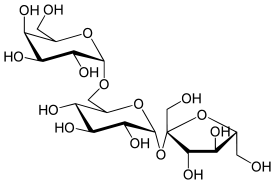Raffinose
 | |
 | |
| Names | |
|---|---|
| IUPAC name
(2R,3R,4S,5S,6R)-2-[(2S,3S,4S,5R)-3,4-dihydroxy-2,5-bis(hydroxymethyl)oxolan-2-yl]oxy-6-[[(2S,3R,4S,5R,6R)-3,4,5-trihydroxy-6-(hydroxymethyl)oxan-2-yl]oxymethyl]oxane-3,4,5-triol | |
| Other names
rafinosa D-(+)-Raffinose D-Raffinose D-raffinose pentahydrate Gossypose Melitose Melitriose NSC 170228 NSC 2025 6G-α-D-galactosylsucrose; β-D-fructofuranosyl-O-α-D-galactopyranosyl-(1→6)-α-D-glucopyranoside hydrate(1:5) | |
| Identifiers | |
| |
3D model (JSmol) |
|
| ChEBI | |
| ChEMBL | |
| ChemSpider | |
| ECHA InfoCard | 100.007.407 |
| EC Number | 208-146-9 |
PubChem CID |
|
| UNII | |
| |
| |
| Properties | |
| C18H32O16 | |
| Molar mass | 504.438 g/mol (pentahydrate) |
| Melting point | 118 °C |
| 203 g/L | |
Except where otherwise noted, data are given for materials in their standard state (at 25 °C [77 °F], 100 kPa). | |
| Infobox references | |
Raffinose is a trisaccharide composed of galactose, glucose, and fructose. It can be found in beans, cabbage, brussels sprouts, broccoli, asparagus, other vegetables, and whole grains. Raffinose can be hydrolyzed to D-galactose and sucrose by the enzyme α-galactosidase (α-GAL), an enzyme not found in the human digestive tract. α-GAL also hydrolyzes other α-galactosides such as stachyose, verbascose, and galactinol, if present. The enzyme does not cleave β-linked galactose, as in lactose.
The raffinose family of oligosaccharides (RFOs) are alpha-galactosyl derivatives of sucrose, and the most common are the trisaccharide raffinose, the tetrasaccharide stachyose, and the pentasaccharide verbascose. RFOs are almost ubiquitous in the plant kingdom, being found in a large variety of seeds from many different families, and they rank second only to sucrose in abundance as soluble carbohydrates.
Humans and other monogastric animals (pigs and poultry) do not possess the α-GAL enzyme to break down RFOs and these oligosaccharides pass undigested through the stomach and upper intestine. In the lower intestine, they are fermented by gas-producing bacteria that do possess the α-GAL enzyme and make carbon dioxide, methane or hydrogen—leading to the flatulence commonly associated with eating beans and other vegetables. α-GAL is present in digestive aids such as the product Beano.
Procedures concerning cryopreservation have used raffinose to provide hypertonicity for cell desiccation prior to freezing.[1] Either raffinose or sucrose is used as a base substance for sucralose.
See also
References
- ↑ Storey B., Noiles, E., Thompson, K. (1998). "Comparison of Glycerol, Other Polyols, Trehalose, and Raffinose to Provide a Defined Cryoprotectant Medium for Mouse Sperm Cryopreservation". Cryobiology. 37 (1): 46–58. doi:10.1006/cryo.1998.2097. PMID 9698429.